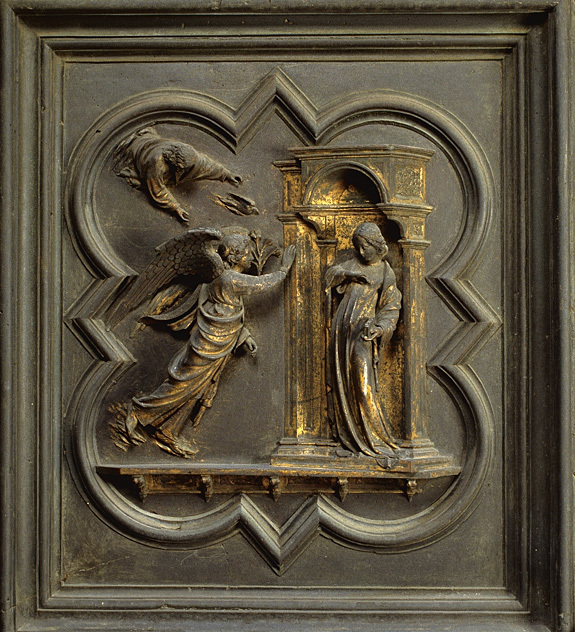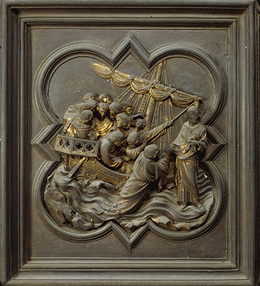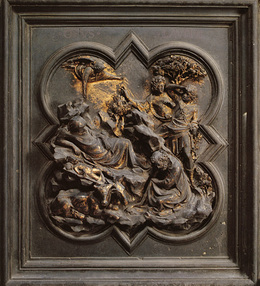Panel I - The Annunciation
Panel details:
John 1:14 and the word became flesh and dwelt among us, and we beheld his glory, the glory as of the only begotten of the father, full of grace and truth.
The annunciation of the Lord to the blessed Virgin Mary is the announcement of the Virginal conception and the Virgin birth of Jesus proclaimed to his mother Mary (gospel according to Luke) and to his father Joseph (gospel according to Matthew) by the archangel Gabriele.
In the gospel according to Matthew, Mary becomes pregnant by the holy spirit, and an angel appears in a dream to Joseph, telling him to keep his wife with him: Matthew 1:18-25: “now the birth of Jesus Christ was as follows: after his mother Mary was betrothed to Joseph, before they came together, she was found with child of the holy spirit. Then Joseph her husband, being a just man, and not wanting to make her a public example, was minded to put her away secretly. But while he thought about these things, behold, an angel of the Lord appeared to him in a dream, saying, “Joseph, son of David, do not be afraid to take to you Mary your wife, for that which is conceived in her is of the holy spirit. And she will bring forth a son, and you shall call his name Jesus, for he will save his people from their sins.” So all this was done that it might be fulfilled which was spoken by the Lord through the prophet, saying: “behold, the Virgin shall be with child, and bear a son, and they shall call his name immanuel,” which is translated, “God with us”. Then Joseph, being aroused from sleep, did as the angel of the Lord commanded him and took to him his wife, and did not know her till she had brought forth her firstborn son. and he called his name Jesus.”
In the gospel according to Luke, an angel comes into the house of Mary and announces that she will conceive the son of God:
Luke 1:26-37: “now in the sixth month the angel Gabriel was sent by God to a city of Galilee named Nazareth, to a Virgin betrothed to a man whose name was Joseph, of the house of David. The Virgin’s name was Mary. and having come in, the angel said to her, “rejoice, highly favoured one, the Lord is with you; blessed are you among women!” but when she saw him, she was troubled at his saying, and considered what manner of greeting this was. Then the angel said to her, “do not be afraid, Mary, for you have found favour with God. And behold, you will conceive in your womb and bring forth a son, and shall call his name Jesus. He will be great, and will be called the son of the highest; and the Lord God will give him the throne of his father David. And he will reign over the house of jacob forever, and of his kingdom there will be no end”. Then Mary said to the angel, “how can this be, since i do not know a man”? and the angel answered and said to her, “the holy spirit will come upon you, and the power of the highest will overshadow you; therefore, also, that holy one who is to be born will be called the son of God. nNow indeed, Elizabeth your relative has also conceived a son in her old age; and this is now the sixth month for her who was called barren. For with God nothing will be impossible”. Then Joseph, being aroused from sleep, did as the angel of the Lord commanded him and took to him his wife, and did not know her till she had brought forth her firstborn son. and he called his name Jesus. Then Mary said, “behold the maidservant of the Lord ! let it be to me according to your word”. and the angel departed from her.”
The two evangelists narrated the announcement evidencing the specific aspects of each of their pastoral and theological intents:
- Matthew was writing primarily to Christians converted from judaism, therefore, he narrated matters pertinent and interesting for those who belonged to that cultural tradition, particularly in reference to the reactions that a man could and should have according to the Law of Moses in the compromising situation of the bride already with child. Additional confirmation of Matthew’s pastoral intentions are to be found in the old testament (Isaiah’s prophecy of the coming of the messiah) substantiating the facts he narrated.
- Luke focused his narrative on the women, recounting the stories of Mary of Nazareth, Magdalene and several other women, exalting them as examples of faith during the public life of Jesus. Hence, the central theme is focused on the story of Mary, her inner turmoil, her consequent resolve and response to the announcement of the angel. There is no quote or prophecy from the old testament to verify the narration; there is, instead, the experience of another woman.
The apocryphal protevangelium of James (mid-second century) also includes a narration of the annunciation:
«Mary took the pitcher and went forth to fill it with water: and lo a voice saying: hail, thou that art highly favoured; the Lord is with thee: blessed art thou among women. And she looked about her upon the right hand and upon the left, to see whence this voice should be: and being filled with trembling she went to her house and set down the pitcher, and took the purple and sat down upon her seat and drew out the thread. And behold an angel of the Lord stood before her saying: fear not, Mary, for thou hast found grace before the Lord of all things, and thou shalt conceive of his word. And she, when she heard it, questioned in herself, saying: shall i verily conceive of the living God, and bring forth after the manner of all women? And the angel of the Lord said: not so, Mary, for a power of the Lord shall overshadow thee: wherefore also that holy thing which shall be born of thee shall be called the son of the highest. And thou shalt call his name Jesus: for he shall save his people from their sins. And Mary said: behold the handmaid of the Lord is before him: be it unto me according to thy word”. »
The version in the gospel of pseudo-Matthew (8th-9th century) is comprised of selections from the protevangelium of James and various other apocryphal gospels.
Church tradition has unanimously acknowledged the angel’s annunciation to Mary and her meek acceptance as the beginning of the history of the definite and everlasting covenant at the precise moment when “the word became flesh”. In the Old testament, God had spoken to the patriarchs, the prophets and the wise. God alternatively communicate the annunciation directly to a young woman. The brief passage in the gospel of Luke summarizes and is testimony of the modesty of the scene: a poor, young girl from a small city in the province of Galilee in contrast to the angel’s promises, which are expressions of power and the manifestation of God. Expressions and manifestations of God were highly valued in old testament theology. The author contemplates the story in its entirety to emphasize the fact that the story of Jesus and salvation had begun in ancient Israel. The expression Mary uttered, “fiat”, evokes the “here i am” that the most important figures in the Old testament had conveyed, Abraham, Moses, Samuel as well as several other prophets and men of God who acknowledged God’s will and plan, consequently pursuing it. The fathers of the church as well as the great spiritual masters of all time have recognized Mary as not only the person who prompted the definitive covenant, but also the model of faith for all believers. Mary’s “yes” allowed her to generate Jesus in the flesh, thus every believer who says “yes” will consequently lead Christ into his life physically and spiritually.
The catholic church celebrates the annunciation on 25 March, while the orthodox church follows the Gregorian calendar celebrating it on 7 april. In many countries (for instance, in Tuscany until the eighteenth century) new year’s day was established on the day of the annunciation, hence the system of calculating years was called incarnation style. Dates relating to events of Jesus’ childhood such as 25 March established for the annunciation were scheduled in reference to Christmas, indicated solely in the church tradition, as there were no precise references in the gospels. Verification of the historic tradition can be identified in the sacred manuscripts of Qumran (found in 1947 dating between the first and second century ad) preserved by the Dead Sea monks. One of the texts included in these manuscripts is the book of Jubilees, dating to the second century b.C., which after nearly two millennia has allowed us to finally discover the dates the Jewish clerical classes officiated in the temple of Jerusalem. Taking into consideration Zachariah entered the temple on 23 September, the day the gospel of Luke indicated that archangel Gabriel announced the birth of his son, this would imply that the precursor of the Lord might have been born around 24 june, about nine months after the annunciation. The gospel emphasizes the six-month difference between the births of John and Jesus; consequently, the annunciation date of the conception of Jesus coincides with 25 March. This rational deduction conciliated traditions consolidated in the west as well as in the east in mid to end of the 4th century. Moreover, the date of the annunciation has a theological and liturgical value. It is regarded the historic moment marking the beginning of the incarnation and the history of salvation, which falls in the same period that Jewish tradition established the beginning of the religious year in the month of Nisan (March / April). The date 25 March marked the beginning of the annual liturgical cycle of Christianity up until the high middle ages, after which it was moved to Christmas and subsequently to the advent, and it also marked the beginning of the civic calendar (such as in ancient Florence). The correspondence to important astronomical cycles aided in establishing the date. Bearing in mind that the date of Christmas was deliberately selected to coincide with the period of Winter solstice, the annunciation would fall in the vernal equinox. Ancient tradition identifies Mary’s house, where the annunciation occurred, a Grotto that now lies in the crypt of the church of the annunciation in Nazareth. One section of the house was partially dug into the rock (the Grotto) and the other section was constructed. The latter remained in Nazareth until the end of the thirteenth century, when it was transported first to Tersatto (Trsat, Croatia) and afterwards to Loreto in Italy, as it was feared the Muslims who had re-occupied the holy land would destroy it. Tradition narrates that it was miraculously carried in flight by angels (The Madonna of Loreto is venerated the patron saint of aviators). In reality, documents of the period demonstrate that the angeli Comneno family, a branch of the Byzantine imperial family ordered the house to be transported by ship between 1291 and 1294. The holy house, as it is called, is still inside the basilica of Loreto, and it is the destination of multitudes of pilgrims.
- In art, the annunciation is one of the most beloved and fascinating themes portrayed in relation to the entire gospel of Luke. It combines mysticism with realism and is equally depicted in cycles of paintings dedicated to Mary, as well as a separate and distinct scene. The images of the annunciation are divided into two sectors, which has facilitated depictions of the scene on the back of panels of triptychs or panelled altars. Through the centuries painters and sculptors have portrayed the psychological reactions of Mary, the fascinating nature of the angel, God’s will, the furniture and the descriptions of the abundant symbolic details.
The iconography of the vast majority of depictions of the annunciation emphasizes:
- Mary’s surprise and turmoil upon hearing the annunciation;
- pure, Virginal love, symbolized by the lily that the angel holds in his hand;
- Mary’s modesty and humility, expressed through her remissive demeanour and
the simplicity of the furnishings;
- Mary’s devotion to the Lord illustrated via the prayer book open in front of
her; the presence of God and the dove of the holy spirit.
- the angel imparting the announcement.
- in byzantine art, there is a rare iconography inspired by the protevangelium of James. The annunciation is set next to a well where Mary had gone to draw water and fill a pitcher. The pitcher is the symbol of the Virgin Mary who at the moment of the annunciation is preparing to become the “container” of the living water: Jesus. Water undeniably had a powerful symbolic value in sacred scripture for those who drank the living water would no longer suffer spiritual thirst.
- the transcription of the words on the scroll of the annunciation, revealing the verbal exchange between the Virgin and the angel, appeared for the first time in the early middle ages.
- in the 11th century, the dove represented the act of conception occurring in the ear of the Virgin. In the 12th century, the image of the holy spirit was depicted in the vestiges of the dove descending from above in a beam of light toward Mary’s ear. Extraordinary examples of this iconography are found in the mosaics in the Cathedral of Monreale in Palermo, Italy.
- in the 11th century, the iconography of Mary was further enriched with the attribute of a book, accompanied by a pulpit or lectern. This iconography was influenced by Franciscan spirituality that emphasized the compassion of Mary (rather than the royalty). The image of the book has been used to reference the fact that Mary was reading one of the prophecies of Isaiah in the bible concerning the conception of Jesus. Franciscan influence is also visible in the gradual “humanization” of a number of scenic elements and scenes of interiors were depicted more realistically.
- a further new element was introduced reflecting Franciscan spirituality, representing the conception. It was the image of the child Jesus carrying the cross on his shoulders as he descends towards Mary in a ray of light. This imagery concurs with the belief that Jesus was not formed “in the uterus”, but had been brought down from heaven by God (“emissus caelitus”) and entered already formed into the womb of the Virgin.
- in the fourteenth century, worldly existence was increasingly portrayed in the annunciation scenes and is visible in the background, the architecture, the furnishings and the decor.
- in the 12th century, the angel was depicted kneeling before the blessed Virgin as represented, for example, on a column in the cloister of Santo Domingo de
Silos in Spain. In French cathedrals angels are often represented as knights. This type of iconography reflects court life and in particular, the feudal custom of knights bending down on one knee in reverence in the presence of a lady.
At the end of the thirteenth century, Mary is depicted on her knees when she gives her consent (“fiat”), as archangel Gabriel promptly follows her.
- in the thirteenth century, another important aspect of the iconography of the annunciation was introduced: the figure of God the Father. Often only the head and shoulders were depicted as can be observed in the annunciation by Pietro Cavallini located in the church of Santa Maria in Trastevere in Rome, Italy. The figure of the father, as well as that of the holy spirit, emphasized the active role of the holy trinity at the conception. This idea is further symbolized architecturally using structural attributes that recall the number three, for example, three lights, three arches, etc. (Flemish masterpieces place particular significance on these attributes).
- Giotto and his contemporaries altered the established depiction of Mary. They no longer portrayed the Virgin Mary as the unapproachable Theotokos (mother of God); rather, they represented her as the queen who entertained a close relationship with humanity. This iconographic change had an effect on the manner in which angels were represented as well. Gabriel was given some feminine traits and lightness, a heavenly joyfulness, which was completely unknown in Byzantine tradition. In the thirteenth century, there were angel- knights and angel-women, as well as angel-priests wearing ecclesiastical vestments in the iconography of northern European art.
- starting in the fourteenth century, the lily - symbol of purity - began to replace the sceptre as the main attribute of Gabriel. Replacing the sceptre with the lily was especially common in Florence, the city whose coat of arms is a red lily. In response to the Florentine iconography, artists in the city of Siena, which was renowned for its devotion to the Virgin Mary, began to represent Gabriel holding an olive branch. In northern European art the lily is often depicted in a vase rather than in the hands of the divine messenger who holds a sceptre as well. Occasionally, the lily is associated with other flowers such as the rose (symbol of charity) and the violet (humility).
The oldest depiction of the annunciation to the Virgin, in addition to that located in the catacombs of Priscilla in Rome, Italy, is a fresco in the Christian church of dura-europos in Syria, which dates to the mid-third century. The women depicted in this fresco are holding jugs, which would appear to refer to the iconography suggested in the protevangelium of James.
Ghiberti created the panel depicting the nativity on the North Door of the Baptistery in Florence in the early stage of his work, evidenced by the similarities of the spatial and stylistic composition to the panel of the competition dated 1401, as Krautheimer indicated in his studies (1937.1956). The composition occupies the entire space of the quatrefoil frame and is developed along the diagonals of the frame. God is portrayed on the upper right side of the panel emerging from the frame representing a three-dimensional relevance. Nearby, the dove of the holy spirit in flight is also oriented toward the Virgin. Below, on the lower right side of the panel the angel God sent to communicate the announcement is standing suspended in air, moved by the divine spirit. There is a bouquet of lilies in the background near the angel, a symbol clearly referring to the Virginal purity of Mary. The Virgin is portrayed in a structure representing classical Renaissance architecture including columns and moulded cornices supporting a barrel-vaulted rounded arch. Mary is standing, conveying a gesture of astonishment and intimidation in the presence of the angel. The figures are represented according to the established iconography of the international gothic style, which characterized Ghiberti’s early works. The positions of the figures and the generous, almost lavish drapery of the garments bestow upon the composition a refined and elegant juxtaposition creating a highly dramatic dialogue of movement.



